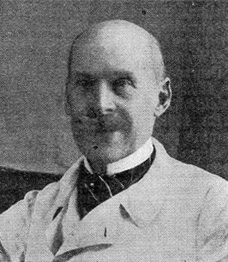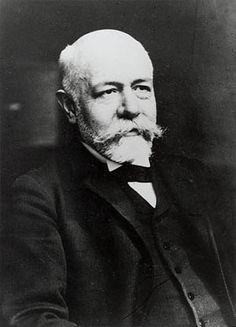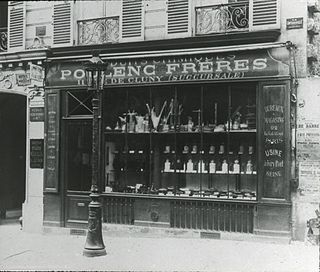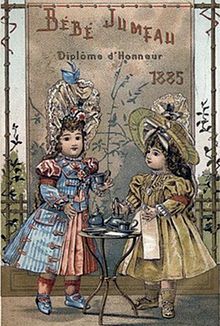
The Exposition Universelle of 1855, better known in English as the 1855 Paris Exposition, was a world's fair held on the Champs-Élysées in Paris, France, from 15 May to 15 November 1855. Its full official title was the Exposition Universelle des produits de l'Agriculture, de l'Industrie et des Beaux-Arts de Paris 1855. It was the first of ten major expositions held in the city between 1855 and 1937. Nowadays, the exposition's sole physical remnant is the Théâtre du Rond-Point des Champs-Élysées, designed by architect Gabriel Davioud, which originally housed the Panorama National.

The Exposition Universelle of 1900, better known in English as the 1900 Paris Exposition, was a world's fair held in Paris, France, from 14 April to 12 November 1900, to celebrate the achievements of the past century and to accelerate development into the next. It was the sixth of ten major expositions held in the city between 1855 and 1937. It was held at the esplanade of Les Invalides, the Champ de Mars, the Trocadéro and at the banks of the Seine between them, with an additional section in the Bois de Vincennes, and it was visited by more than fifty million people. Many international congresses and other events were held within the framework of the exposition, including the 1900 Summer Olympics.

Charles-Émile Reynaud was a French inventor, responsible for the praxinoscope and was responsible for the first projected animated films. His Pantomimes Lumineuses premiered on 28 October 1892 in Paris. His Théâtre Optique film system, patented in 1888, is also notable as the first known instance of film perforations being used. The performances predated Auguste and Louis Lumière's first paid public screening of the cinematographe on 26 December 1895, often seen as the birth of cinema.

The Exposition Universelle of 1878, better known in English as the 1878 Paris Exposition, was a world's fair held in Paris, France, from 1 May to 10 November 1878, to celebrate the recovery of France after the 1870–71 Franco-Prussian War. It was the third of ten major expositions held in the city between 1855 and 1937.

Carlos Schwabe was a Swiss Symbolist painter and printmaker.
The Société Française de Fabrication de Bébés et Jouets was a large doll making consortium founded in France by the union of a number of major French doll companies including Jumeau and Bru and the Franco-German doll company Fleischmann & Bloedel in 1899. The company went out of business in the late 1950s.

The Exposition Universelle of 1867, better known in English as the 1867 Paris Exposition, was a world's fair held in Paris, France, from 1 April to 3 November 1867. It was the second of ten major expositions held in the city between 1855 and 1937. A number of nations were represented at the fair. Following a decree of Emperor Napoleon III, the exposition was prepared as early as 1864, in the midst of the renovation of Paris, marking the culmination of the Second French Empire. Visitors included Tsar Alexander II of Russia, a brother of the King William and Otto von Bismarck of Prussia, Prince Metternich and Franz Josef of Austria, Ottoman Sultan Abdülaziz, and the Khedive of Egypt Isma'il.
A Black doll is a doll of a black person. Black doll manufacture dates back to the 19th century, with representations being both realistic and stereotypical. More accurate, mass-produced depictions are manufactured today as toys and adult collectibles.
Events from the year 1889 in France.

Pierre-François Jumeau, was the founder of Jumeau. Jumeau was an 1840s French firm that produced bisque dolls and china dolls. His second son Emile-Louis Jumeau, born in 1843, began assuming management of the company in the 1870s.

Gaston La Touche, or de La Touche, was a French painter, illustrator, engraver and sculptor.

A bisque doll or porcelain doll is a doll made partially or wholly out of bisque or biscuit porcelain. Bisque dolls are characterized by their realistic, skin-like matte finish. They had their peak of popularity between 1860 and 1900 with French and German dolls. Bisque dolls are collectible, and antique dolls can be worth thousands of dollars. Antique German and French bisque dolls from the 19th century were often made as children's playthings, but contemporary bisque dolls are predominantly made directly for the collectors market.
François-Désiré Froment-Meurice was a French goldsmith, working in a free and naturalistic manner in the tradition of Mannerist and Baroque masters. One version of his Coupe des Vendanges, the "Harvest Cup", made in 1844, is conserved at the Musée du Louvre.

A composition doll is a doll made partially or wholly out of composition, a composite material composed of sawdust, glue, and other materials such as cornstarch, resin and wood flour. The first composition dolls were made in the 19th century.
Léon Messagé (1842-1901) was a French sculptor, best known for his sculptural collaboration with François Linke for the 1900 Paris Exposition Universelle. Messagé was also responsible for much of the design and creative work for Roux et Brunet and Joseph-Emmanuel Zwiener.

Simon & Halbig was a doll manufacturer known for bisque doll heads with subtle colouring. They were based in Thuringia, the centre of the German doll industry. They supplied doll heads to many other well known doll makers. These are now collectables.

Charles Oudin is one of the oldest French horology firms. It was founded in Paris at the end of the 18th century by Jean-Charles Oudin, who came from a family of clockmakers in Northwest France. There were four generations of Oudins who were clockmakers, as of the mid 18th century, first in the Meuse region and later, in Paris. Several members of the Oudin family worked for the master watch and clockmaker Abraham-Louis Breguet.

Lucien Falize was a French jeweller and writer in France who was responsible for pioneering and driving the Art Nouveau movement with his firm, Falize. He is known for his breathtaking and innovative designs for both public and private sales.

Poulenc Frères was a French chemical, pharmaceutical and photographic supplies company that had its origins in a Paris pharmacy founded in 1827. From 1852 it began to manufacture photographic chemicals. It took the name Poulenc Frères in 1881, and by 1900 had a range of high-quality products. That year it went public as the Établissements Poulenc Frères. It began production of synthetic medicines, and continued to grow during World War I (1914–18). In 1928 it merged with the Société des usines chimiques du Rhône to form Rhône-Poulenc.

Émile-Jean Sulpis was a French engraver and designer.

















